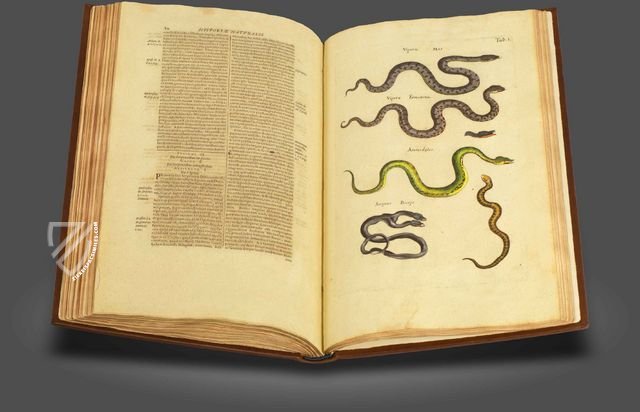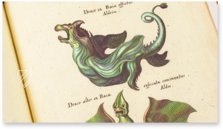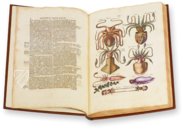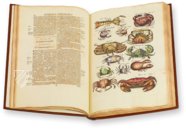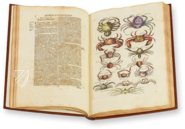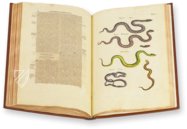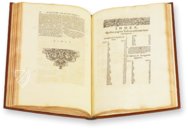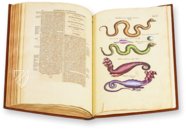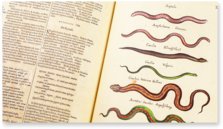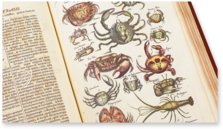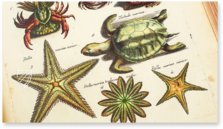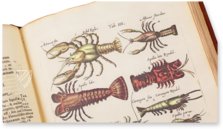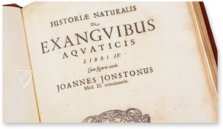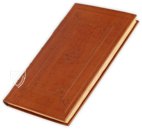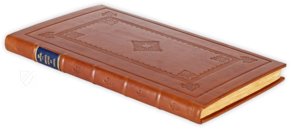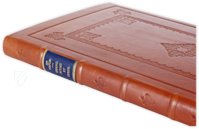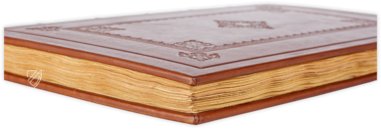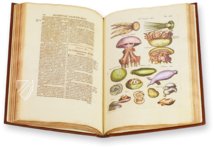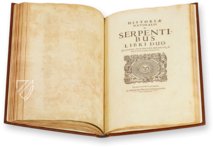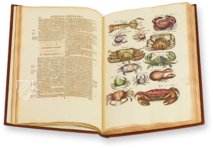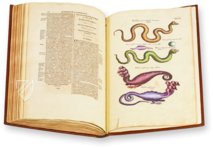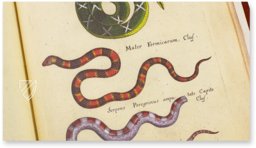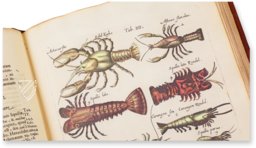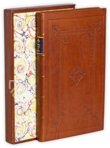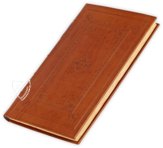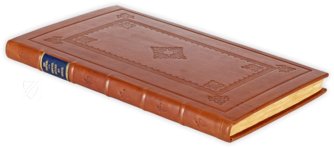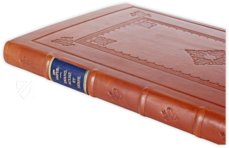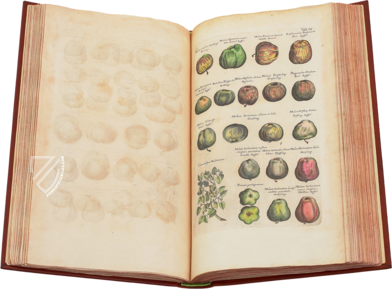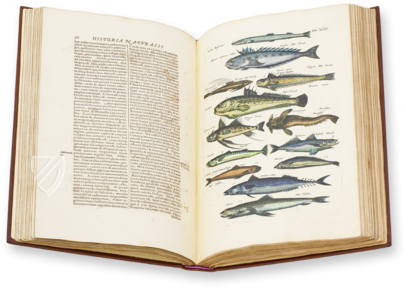Historia Naturalis: De Exanguibus Acuaticis et Serpentibus
(3,000€ - 7,000€)
The Historia naturalis animalium, written by the Polish Renaissance man John Jonston in the mid– 17th century, was long considered to be the standard work of zoology in Europe. This “most broadly disseminated zoological handbook” experienced numerous republications and translations into other languages. The encyclopedic overview work about the history of animals assembles numerous descriptions of animals in five books. Tables with wonderful copperplate engravings by Matthäus Merian the Younger illustrate the zoological work. One volume of the series concerns itself with the Historia naturalis de exanguibus acuaticis et serpentibus, so with bloodless aquatic animals, snakes, and reptiles. As a part of the zoology of John Jonston, today it simultaneously offers a scientific and entertaining overview of these animals.
Historia Naturalis: De Exanguibus Acuaticis et Serpentibus
The Historia naturalis animalium, written by the Polish Renaissance man John Jonston in the mid– 17th century, was long considered to be the standard work of zoology in Europe. This “most broadly disseminated zoological handbook” experienced numerous republications and translations into other languages. The encyclopedic overview work about the history of animals assembles numerous descriptions of animals in five books. Tables with wonderful copperplate engravings by Matthäus Merian the Younger illustrate the zoological work. One volume of the series concerns itself with the Historia naturalis de exanguibus acuaticis et serpentibus, so with bloodless aquatic animals, snakes, and reptiles. As a part of the zoology of John Jonston, today it simultaneously offers a scientific and entertaining overview of these animals.
Muscles, Snakes, and Four-Headed Dragons
Across 204 pages, the volume of the Historia Naturalis de exanguibus acuaticis et serpentibus collects a total of 32 tables with the wonderful copperplate engravings of Matthäus Merian. Over 300 animals are pictorially represented here in addition to the text. The section about bloodless aquatic creatures contains an overview of mollusks, shellfish, and crustaceans. Following thereafter is a chapter on snakes and reptiles. The copperplate engravings – expertly executed and of the highest quality – show squids, all kinds of crabs, sea stars, and other aquatic animals. Additionally, there is a diverse list of muscles, jellyfish, sea urchins, etc. Countless snakes slither across the pages of the second section, which are detailed with their respective patterns and in all possible sizes. The three last miniature pages of the text concern themselves with dragon-like animals. Here again, curious and fantastical creatures are depicted: snakes with multiple heads or with small wings and feet.
The Renaissance Man John Jonston
John Jonston (1603–1675) was the son of Scottish parents, a doctor, and a Renaissance man from Poland. Through tours and visits of study across all of Europe, John collected a general knowledge that encompassed a variety of disciplines, which he transmitted as a tutor and tour guide to young nobles. He was famous nevertheless through his scientific-pedagogical writings concerning such diverse topics as child-rearing, philosophy and theology, history, but also medicine and mineralogy, all before the famous five-volume Historia Naturalis. Jonston did not want to write down any new knowledge, but rather to spread preexisting knowledge. Therefore, he drew on sources from ancient and contemporary authors and collected his findings in an encyclopedic work.
Standard Work of Zoology
For his incomplete magnum opus, Jonston planned a comprehensive illustrated depiction of the world of animals, plants, and people. The Historia Naturalis Animalium was printed from 1650 to 1653 in the publishing house of Matthäus Merian the Younger in Frankfurt am Main. Merian (1621–1687), who learned from Joachim von Sandrart and Anthonis van Dyck, was active as a painter, copperplate engraver, and publisher. He undertook the artistic design of the editions on behalf of John Jonston and published the series in the famous Frankfurt atelier of his father, Matthäus Merian the Elder, which he had taken over. The marvelous illustrations, colorfully illustrated moreover, lend the sophisticated publication its final touches and are surely a reason for the exceptional popularity of the Historia Naturalis across Europe.
Codicology
- Size / Format
- 204 pages / 38.0 × 22.0 cm
- Origin
- Netherlands
- Date
- 1650–1653
- Epochs
- Style
- Language
- Illustrations
- 32 copperplate engravings with more than 300 animal representations
- Artist / School
- Johannes Jonstonus (John Jonston) (1603–1675) (author)
Matthaeus Merian The Younger (1621–1687) (engraver)
Historia Naturalis: De Exanguibus Acuaticis et Serpentibus
Horned Vipers
Ranging across Southeastern Europe and parts of Anatolia, the horned viper is a highly venomous snake. The word ammodytes is derived from Greek meaning “sand burrower”, although this name is deceiving because they prefer rocky hillsides to sand. Two variations – one green and another brown – are shown. Below them we see a black two-headed snake labelled Serpens Biceps, which has been born with polycephaly. Multi-headed snakes have appeared in various mythic traditions.

Historia Naturalis: De Exanguibus Acuaticis et Serpentibus
Cephalopods
Of all the creatures of the sea, few are as interesting as cephalopods – a class of mollusk encompassing squids, cuttlefish, and octopuses. Characterized by their tentacles, prominent heads, bilateral body symmetry, and ability to shoot ink, they are extremely exotic in appearance and have the ability to change colors within milliseconds either for the purposes of communication or camouflage.
The page at hand presents these surprisingly intelligent creatures with an incredible color palette: the octopus in the upper left in a reddish orange with green eyes, the pastel-purple cuttlefish at the bottom, and the multicolored squid in between. These woodcuts are remarkable for their realism and careful attention to detail.
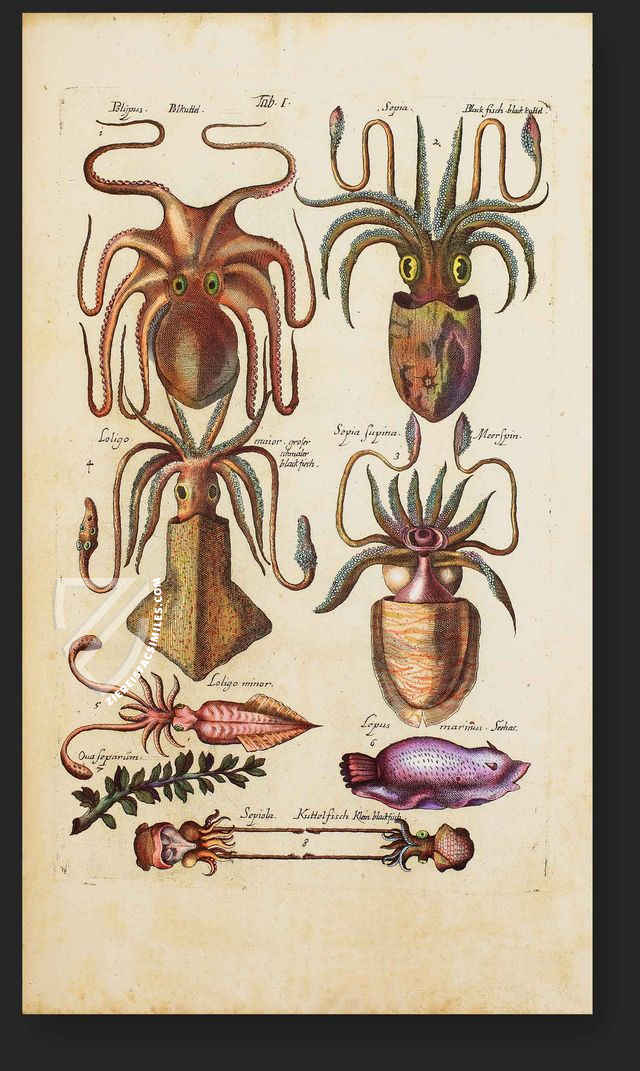
#1 Historia Naturalis: De Exanguibus Acuaticis et Serpentibus
Language: Spanish
(3,000€ - 7,000€)
- Treatises / Secular Books
- Apocalypses / Beatus
- Astronomy / Astrology
- Bestiaries
- Bibles / Gospels
- Chronicles / History / Law
- Geography / Maps
- Saints' Lives
- Islam / Oriental
- Judaism / Hebrew
- Single Leaf Collections
- Leonardo da Vinci
- Literature / Poetry
- Liturgical Manuscripts
- Medicine / Botany / Alchemy
- Music
- Mythology / Prophecies
- Psalters
- Other Religious Books
- Games / Hunting
- Private Devotion Books
- Other Genres
- Afghanistan
- Armenia
- Austria
- Belgium
- Colombia
- Croatia
- Cyprus
- Czech Republic
- Denmark
- Egypt
- Ethiopia
- France
- Germany
- Greece
- Hungary
- India
- Iran
- Iraq
- Israel
- Italy
- Japan
- Lebanon
- Luxembourg
- Mexico
- Morocco
- Netherlands
- Palestine
- Peru
- Poland
- Portugal
- Russia
- Serbia
- Spain
- Sri Lanka
- Sweden
- Switzerland
- Syria
- Turkey
- Ukraine
- United Kingdom
- United States
- Uzbekistan
- Aboca Museum
- Ajuntament de Valencia
- Akademie Verlag
- Akademische Druck- u. Verlagsanstalt (ADEVA)
- Aldo Ausilio Editore - Bottega d’Erasmo
- Alecto Historical Editions
- Alkuin Verlag
- Almqvist & Wiksell
- Amilcare Pizzi
- Andreas & Andreas Verlagsbuchhandlung
- Archa 90
- Archiv Verlag
- Archivi Edizioni
- Arnold Verlag
- ARS
- Ars Magna
- ArtCodex
- AyN Ediciones
- Azimuth Editions
- Badenia Verlag
- Bärenreiter-Verlag
- Belser Verlag
- Belser Verlag / WK Wertkontor
- Benziger Verlag
- Bernardinum Wydawnictwo
- BiblioGemma
- Biblioteca Apostolica Vaticana (Vaticanstadt, Vaticanstadt)
- Bibliotheca Palatina Faksimile Verlag
- Bibliotheca Rara
- Boydell & Brewer
- Bramante Edizioni
- Bredius Genootschap
- Brepols Publishers
- British Library
- C. Weckesser
- Caixa Catalunya
- Canesi
- CAPSA, Ars Scriptoria
- Caratzas Brothers, Publishers
- Carus Verlag
- Casamassima Libri
- Chavane Verlag
- Christian Brandstätter Verlag
- Circulo Cientifico
- Club Bibliófilo Versol
- Club du Livre
- CM Editores
- Collegium Graphicum
- Collezione Apocrifa Da Vinci
- Comissão Nacional para as Comemorações dos Descobrimentos Portugueses
- Coron Verlag
- Corvina
- CTHS
- D. S. Brewer
- Damon
- De Agostini/UTET
- De Nederlandsche Boekhandel
- De Schutter
- Deuschle & Stemmle
- Deutscher Verlag für Kunstwissenschaft
- DIAMM
- Droz
- E. Schreiber Graphische Kunstanstalten
- Ediciones Boreal
- Ediciones Grial
- Ediclube
- Edições Inapa
- Edilan
- Editalia
- Edition Deuschle
- Edition Georg Popp
- Edition Leipzig
- Edition Libri Illustri
- Editiones Reales Sitios S. L.
- Éditions de l'Oiseau Lyre
- Editions Medicina Rara
- Editorial Casariego
- Editorial Mintzoa
- Editrice Antenore
- Editrice Velar
- Edizioni Edison
- Egeria, S.L.
- Eikon Editores
- Electa
- Emery Walker Limited
- Enciclopèdia Catalana
- Eos-Verlag
- Ephesus Publishing
- Ernst Battenberg
- Eugrammia Press
- Extraordinary Editions
- Fackelverlag
- Facsimila Art & Edition
- Facsimile Editions Ltd.
- Facsimilia Art & Edition Ebert KG
- Faksimile Verlag
- Feuermann Verlag
- Folger Shakespeare Library
- Franco Cosimo Panini Editore
- Friedrich Wittig Verlag
- Fundación Hullera Vasco-Leonesa
- G. Braziller
- Gabriele Mazzotta Editore
- Gebr. Mann Verlag
- Gesellschaft für graphische Industrie
- Getty Research Institute
- Giovanni Domenico de Rossi
- Giunti Editore
- Graffiti
- Grafica European Center of Fine Arts
- Guido Pressler
- Guillermo Blazquez
- Gustav Kiepenheuer
- H. N. Abrams
- Harrassowitz
- Helikon
- Hendrickson Publishers
- Henning Oppermann
- Herder Verlag
- Hes & De Graaf Publishers
- Hoepli
- Holbein-Verlag
- Hortus Deliciarum
- Houghton Library
- Hugo Schmidt Verlag
- Idion Verlag
- Il Bulino, edizioni d'arte
- ILte
- Imago
- Insel Verlag
- Instituto Nacional de Antropología e Historia
- Istituto dell'Enciclopedia Italiana - Treccani
- Istituto Ellenico di Studi Bizantini e Postbizantini
- Istituto Geografico De Agostini
- Istituto Poligrafico e Zecca dello Stato
- Italarte Art Establishments
- J. Thorbecke
- Jan Thorbecke Verlag
- Johnson Reprint Corporation
- Josef Stocker
- Josef Stocker-Schmid
- Jugoslavija
- Karl W. Hiersemann
- Kasper Straube
- Kaydeda Ediciones
- Kindler Verlag / Coron Verlag
- Kodansha International Ltd.
- Konrad Kölbl Verlag
- Kurt Wolff Verlag
- La Liberia dello Stato
- La Linea Editrice
- La Meta Editore
- Lambert Schneider
- Landeskreditbank Baden-Württemberg
- Leo S. Olschki
- Les Incunables
- Library of Congress
- Libreria Musicale Italiana
- Lichtdruck
- Lito Immagine Editore
- Lumen Artis
- Lund Humphries
- M. Moleiro Editor
- Maison des Sciences de l'homme et de la société de Poitiers
- Manuscriptum
- Martinus Nijhoff
- Maruzen-Yushodo Co. Ltd.
- MASA
- McGraw-Hill
- Militos
- Millennium Liber
- Müller & Schindler
- Nahar and Steimatzky
- National Library of Wales
- Neri Pozza
- Nova Charta
- Oceanum Verlag
- Odeon
- Orbis Mediaevalis
- Orbis Pictus
- Österreichische Staatsdruckerei
- Oxford University Press
- Pageant Books
- Parzellers Buchverlag
- Patrimonio Ediciones
- Pattloch Verlag
- PIAF
- Pieper Verlag
- Plon-Nourrit et cie
- Prestel Verlag
- Princeton University Press
- Prisma Verlag
- Priuli & Verlucca, editori
- Pro Sport Verlag
- Propyläen Verlag
- Pytheas Books
- Quaternio Verlag Luzern
- Reales Sitios
- Recht-Verlag
- Reichert Verlag
- Reichsdruckerei
- Riehn & Reusch
- Roberto Vattori Editore
- Rosenkilde and Bagger
- Roxburghe Club
- Salerno Editrice
- Sarajevo Svjetlost
- Schöck ArtPrint Kft.
- Scolar Press
- Scrinium
- Scripta Maneant
- Scriptorium
- Siloé, arte y bibliofilia
- SISMEL - Edizioni del Galluzzo
- Sociedad Mexicana de Antropología
- Société des Bibliophiles & Iconophiles de Belgique
- Soncin Publishing
- Sorli Ediciones
- Stainer and Bell
- Studer
- Styria Verlag
- Sumptibus Pragopress
- Szegedi Tudomànyegyetem
- Taberna Libraria
- Tarshish Books
- Taschen
- Tempus Libri
- Testimonio Compañía Editorial
- Thames and Hudson
- The Clear Vue Publishing Partnership Limited
- The Facsimile Codex
- The Folio Society
- The Marquess of Normanby
- The Richard III and Yorkist History Trust
- Tip.Le.Co
- TouchArt
- TREC Publishing House
- TRI Publishing Co.
- Trident Editore
- Typis Regiae Officinae Polygraphicae
- Union Verlag Berlin
- Universidad de Granada
- University of California Press
- University of Chicago Press
- Urs Graf
- Vallecchi
- Van Wijnen
- VCH, Acta Humaniora
- VDI Verlag
- VEB Deutscher Verlag für Musik
- Verlag Anton Pustet / Andreas Verlag
- Verlag Bibliophile Drucke Josef Stocker
- Verlag der Münchner Drucke
- Verlag für Regionalgeschichte
- Verlag Styria
- Vicent Garcia Editores
- W. Turnowsky
- Waanders Printers
- Wiener Mechitharisten-Congregation (Wien, Österreich)
- Wissenschaftliche Buchgesellschaft
- Wydawnictwo Dolnoslaskie
- Xuntanza Editorial
- Zakład Narodowy
- Zollikofer AG

